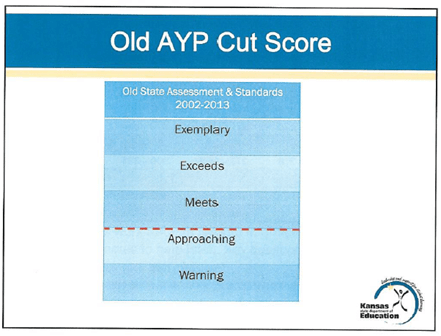At the September State Board of Education meeting, members are scheduled to vote on cut scores that will categorize students based on their performance on the new state assessment completed last spring. What makes this so significant is that both the test and the scoring mechanisms have changed dramatically from previously administered assessments.
Gone are the five performance categories (shown below) that were based on a pass/fail system that were used to determine if schools were meeting Adequate Yearly Progress (AYP) requirements by the feds. (The three categories above the red line were considered passing.)

 The new system couldn’t be more different. The five existing categories have been replaced with four “Performance Levels” shown in the adjacent graphic. Levels now have a number instead of a name, and there is no pass/fail line. Also, placement in a category is based on a weighted scaled score, with a range from 220-380 (a score of 220 meaning zero correct answers with all correct answers giving a score of 380). This differs from the previous state assessments, in which a student was put into a category based on the percentage of correct answers. The other significant change is not readily apparent in the categorizing and reporting. The new test is, as Deputy Education Commissioner Brad Neuenswander told a media group, “an assessment of the College and Career Ready Standards,” (the Kansas version of Common Core).
The new system couldn’t be more different. The five existing categories have been replaced with four “Performance Levels” shown in the adjacent graphic. Levels now have a number instead of a name, and there is no pass/fail line. Also, placement in a category is based on a weighted scaled score, with a range from 220-380 (a score of 220 meaning zero correct answers with all correct answers giving a score of 380). This differs from the previous state assessments, in which a student was put into a category based on the percentage of correct answers. The other significant change is not readily apparent in the categorizing and reporting. The new test is, as Deputy Education Commissioner Brad Neuenswander told a media group, “an assessment of the College and Career Ready Standards,” (the Kansas version of Common Core).
Although KSDE doesn’t assign a unique descriptor to each level, they have provided a grouped description as shown on the graphic. The bracket to the left of the levels in the graphic describes Levels 2, 3 and 4 as “At or Above Academic Expectation for Grade Level.” The bracket on the right defines Levels 3 and 4 as “At or Above Academic Expectations for College and Career Readiness.” If that confuses you, you are not alone.
Below is my descriptor of the four levels. I presented them to Mr. Neuenswander, and he agreed that they are a fair representation of a short description of each category.
- Level 1 is below grade level
- Level 2 is at or above grade level, but not college/career ready
- Level 3 is at or exceeds expectations for college/career ready
- Level 4 is far exceeds expectations for college/career ready
What jumps out immediately is this question: If a student is performing at or above grade level (Level 2), shouldn’t they be on track for being ready for college or career upon graduation?
Also, the lack of an identifier for each level will undoubtedly prove to be confusing to parents, teachers, lawmakers, and the public. When asked by reporters why levels were not named, Mr. Neuenswander responded that the categories were too encompassing and complicated to put a simple word or two descriptor. As a former teacher, I understand completely how difficult it is to apply a simple label to a how a student is performing, but at some point it does come to that. Letter grades are a prime example.
Other issues and concerns:
- The way the Levels graphic is presented, one could infer that the four groups are expected to have roughly the same number of students in each. It even looks like the four levels represent quartiles. Don’t expect that. More likely is that Levels 1 and 2 will be significantly larger than Levels 3 and 4.
- The new reporting method prohibits any comparison to state assessments from previous years. There will be no way to compare the overall new assessment results with prior year results.
- Parents will definitely experience a learning curve in analyzing the results of their children. We were told parents will receive a letter from the state that will not only identify a level, but each student will be identified as a “high” or “low” within each level. Parents will be given a description of strengths and weaknesses through the test results.
- Teachers and schools will also experience a significant learning curve in understanding and how to respond to the results.
- Although the results cannot be compared to the prior test, expect the overall results to be lower due to the newness of the test and the change in the standards.
These questions and concerns notwithstanding, I agree with the overall concept that assessments, their results, and responses to them should be focused on improving student achievement. As Mr. Neuenswander stated, assessments should not be about satisfying a federal requirement, they should be about improving student performance.
Stay tuned for a follow-up blog based on the actions of the State Board of Education.




